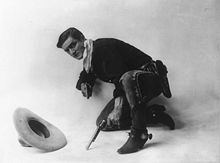Tom Mix
He grew up in nearby DuBois, where his father, a stable master for a wealthy lumber merchant, taught him to ride and love horses.
His unit never went overseas, and Mix later failed to return for duty after an extended furlough when he married Grace I. Allin on July 18, 1902.
In 1905, Mix rode in President Theodore Roosevelt's inaugural parade with a group of 50 horsemen led by Seth Bullock, which included several former Rough Riders.
He stood out as a skilled horseman and expert shot, winning national riding and roping contests at Prescott, Arizona, in 1909, and Canon City, Colorado, in 1910.
In 1910, he appeared as himself in a short documentary film, Ranch Life in the Great Southwest, in which he displayed his skills as a cattle wrangler.
Shot in Dewey, Oklahoma with Selig studio cameramen,[8] the film was a success, and Mix became an early motion picture star.
By then, Selig Polyscope had encountered severe financial difficulties, and Mix and Forde both subsequently signed with Fox Film Corporation, which had leased the Edendale studio.
[3] As a result of Mix's schedule of making six to ten movies per year, and his refusal to let her visit him while he was working, they lived apart during much of their marriage.
Loaded with western props and furnishings, it has been described as a "complete frontier town, with a dusty street, hitching rails, a saloon, jail, bank, doctor's office, surveyor's office, and the simple frame houses typical of the early Western era".
The set also included a simulated desert, a large corral, and (to facilitate interior shots) a ranch house with no roof.
[9] By 1927, low budget imitations of Mix's film spread, which led to Fox further losing interest in keeping him.
[15] Mix threatened to move to Argentina to make films or to join the circus,[16] but agreed to return to Hollywood in July 1928 and signed with FBO.
[9] Mix became friends with Wyatt Earp, who lived in Los Angeles and occasionally visited Hollywood western movie sets.
[19] By 1929, Mix was past his prime and undergoing marriage difficulties, with his fourth wife Victoria, who was already very good at spending his money, taking their daughter Thomasina for an extended European vacation where she proceeded to spend money as if Tom were bringing it in as fast as ever, which was not the case.
Mix's last screen appearance was a 15-episode sound Mascot Pictures serial, The Miracle Rider (1935), for which he received $40,000 for the four weeks of filming.
Outdoor action sequences for the production were filmed primarily on the Iverson Movie Ranch in Chatsworth, California, on the outskirts of Los Angeles.
In one episode, Mix was filmed descending from the top of the rock, with boot holes carved into it to assist him in making the descent.
[23] Mix never appeared on these broadcasts (his voice, damaged by a bullet to the throat and repeated broken noses, was not fit for radio) and was instead played by radio actors: Artells Dickson (early 1930s), Jack Holden (from 1937), Russell Thorsen (early 1940s) and Joe "Curley" Bradley (from 1944).
Most of Mix's radio work has been lost over the years; recordings of only approximately 30 scattered episodes, and no complete story arcs, survive.
[4] A small stone memorial marks the site of his death on State Route 79, and the nearby gully is known as "Tom Mix Wash".
When an injury caused football player Marion Morrison (later known as John Wayne) to drop out of the University of Southern California, Mix helped him find work moving props in the back lot of Fox Studios.
For his contribution to the motion picture industry, Mix has a star on the Hollywood Walk of Fame at 1708 Vine Street.
The memorial consists of a bronze-green spiral of sprocketed "camera film" above a multi-sided tower, embossed with full-length likenesses of early stars who appeared in famous silent movies.
Those memorialized include Douglas Fairbanks, Mary Pickford, Will Rogers, Conrad Nagel, Rudolph Valentino, Fred Niblo, Harold Lloyd, and Mix.









